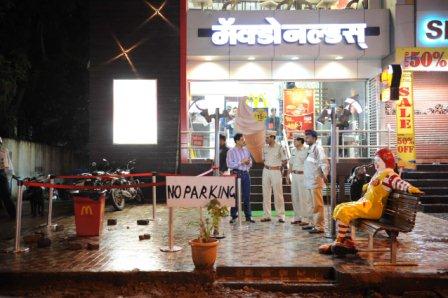Life
Serial Blasts Rock Oxford of the East

Police and Bomb Detection and Disposal Squad (BDDS) examine the dustbin near Mcdonalds on Jangli Maharaj Road where the minor blast took place on Aug. 1 evening.
Of the 40,000 international students pursuing education in India, nearly half are studying in colleges in Pune.
The series of four low intensity blasts that rattled the city of Pune, known as the Oxford of the East and the Silicon Valley of India because of the existence of large number of educational institutes and IT companies, on Aug 1 evening has once again brought to the fore the vulnerability of the city to terror attacks.
The late Prime Minister Jawaharlal Nehru had given Pune the sobriquet of Oxford of the East. On a visit to Pune in the late 1950s, Nehru was so impressed with its array of top-notch educational institutions that he described the city as “the Oxford of the East.” The city quickly embraced the name.
The serial blasts in the busy Jungli Maharaj Road , one of the most crowded and happening places in the city, which is dotted with malls, multiplexes, eateries and posh retail outlets, reopened the old wounds and painful memories of the German Bakery blast, which killed 17 people and injured 65 others on Feb. 13, 2010 in close vicinity of the Osho International Resort and Jewish Chabad House.
The city, which attracts a large number of foreigners, has long been on the radar of terrorist groups. The FBI terror suspect and Laskhar-e-Taiba operative David Headley had visited the Osho commune twice on July 24, 2008 and on March 16, 2009.
On Aug 1 night, the city was rocked by four low intensity blasts on the crowded Junglee Maharaj Road that left one person injured and the entire city stunned. The blast occurred hours after Sushil Kumar Shinde took over as the country’s new home minister.
The Commissioner of Pune Police Gulabrao Pol says that it is premature to dub this incident as a possible terror attack, saying: “We are investigating the matter thoroughly; only then we will be able to say who is behind them. At present we cannot say that the low intensity blasts could be the handiwork of some terror groups.”
Police say that small pencil cells have been recovered, which indicates that pencil cell detonators were likely used in the blasts.
Pune has been India’s premier educational hub for the past 100 years and the seat of education from the times of the Peshwas in the 17th century. International students have descended upon the city in recent decades, making it a more popular destination for study abroad than Mumbai, Delhi, Bangalore, or any other city in the country. As a result, it has also become very popular with NRI students as well.
Of the 40,000 international students who come to India in pursuit of education, as many as 19,000 students head to Pune. Pune University has set up an international students’ center and an estimated 15,000 foreign students have graduated from the university in recent decades.
Besides being home to the famed Film & Television Institute of India (FTII), the alma mater of some of Indian cinema’s finest actors and technicians, Pune is the cradle of India’s military leadership. The National Defence Academy (NDA), which produces officer cadets for all three arms of the defence forces (Army, Navy and Air Force), is located in Khadakwasla, 17 km from Pune.
In addition, this city is a research hub and home to some of the country’s most prestigious research institutes, including the National Chemical Laboratory (NCL), the Central Water and Power Research Station (CWPRS), the National Institute of Virology (NIV), and the Gokhale Institute of Politics and Deccan College.
Pune is a major foreign tourist destination as well. The Osho International Resort’s meditation programs attract tens of thousands of tourists from Europe, United States and Latin America annually.

You must be logged in to post a comment Login